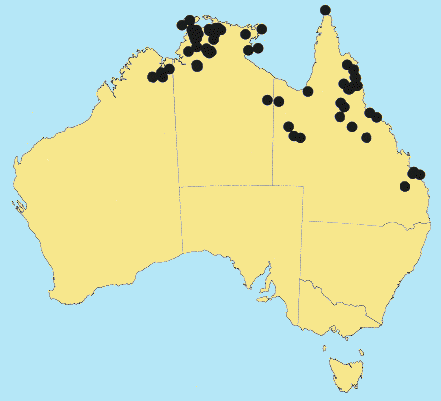Digitaria gibbosa (R. Br.)
Beauv. Ess. Agrost.
160, 169 (1812).
Classification. (GPWG 2001) : Subfamily Panicoideae. Paniceae.
Basionym and/or
Replacement Name: Panicum
gibbosum R. Br., Prodr. 193 (1810).
Type of Basionym or
Protologue Information: HT: R. Brown 6124, Australia (BM; IT: L,
US-80670 (fragm.)).
Key references
(books and floras): [1810]. R.Brown, Prodromus (193 as Panicum
gibbosum), [1878] G.Bentham, Flora Australiensis 7 (471 as Panicum
gibbosum), [2002] D.Sharp & B.K.Simon, AusGrass, Grasses of
Australia.
Habit. Annual.
Rhizomes absent. Stolons absent. Culms erect, 25–40 cm tall, 2–5 -noded.
Mid-culm internodes glabrous. Mid-culm nodes glabrous. Lateral branches
sparsely branched. Leaf-sheaths antrorsely scabrous, glabrous on surface or
hairy. Leaf-sheath auricles present. Ligule a fringed membrane, a ciliolate
membrane, 0.3–1 mm long. Leaf-blades linear or lanceolate, flat, 2.5–15 cm
long, 1–4 mm wide. Leaf-blade surface scabrous, glabrous or indumented.
Inflorescence.
Inflorescence solid, a raceme. Racemes 1, 4–18 cm long.
Spikelets.
Spikelets pedicelled, 2–10(–25) in the cluster. Fertile spikelets 2-flowered,
the lower floret barren (rarely male), the upper fertile, comprising 1 basal
sterile florets, comprising 1 fertile floret(s), without rachilla extension,
elliptic, dorsally compressed, 1.5–2.8 mm long. Rhachilla internodes brief up
to lowest fertile floret.
Glumes. Glumes
thinner than fertile lemma. Upper glume lanceolate, 1.2–2.2 mm long,
membranous, without keels, 3 -nerved. Upper glume surface indumented. Florets.
Basal sterile florets 1, barren, without significant palea. Lemma of lower
sterile floret 100 % of length of spikelet, membranous, 5–7 -nerved.
Fertile lemma 1.5–2.8
mm long, keeled. Lemma apex mucronate. Lodicules absent or vestigial.
Continental
Distribution: Australasia.
Australian
Distribution: Western Australia, Northern Territory, Queensland.
Western Australia:
Gardner. Northern Territory: Darwin & Gulf, Victoria River. Queensland:
Burke, Cook, Mitchell, North Kennedy, South Kennedy.
Notes.
A spicate inflorescence, relatively long setaceous hairs overtopping the
spikelet, a keeled upper lemma, and a hair-fringed ligule makes D. gibbosa
a distinctive, easily recognizable Australian endemic. It is closely related to
D. leucostachya and certain African members of the section Monodactylae.
In tropical and subtropical sub-humid woodlands and
coastal grasslands. Flowers sporadically, Jan.-Sept




x
